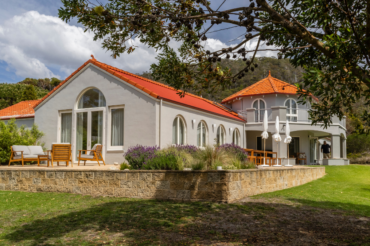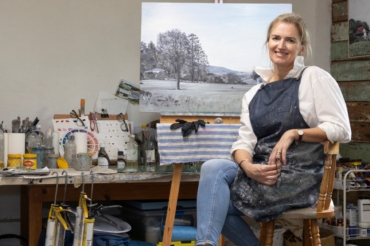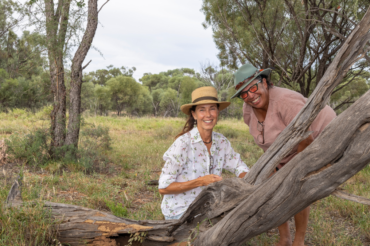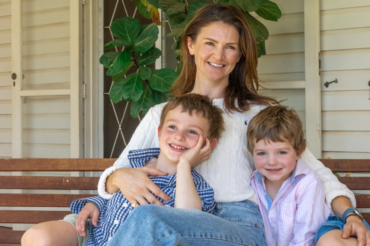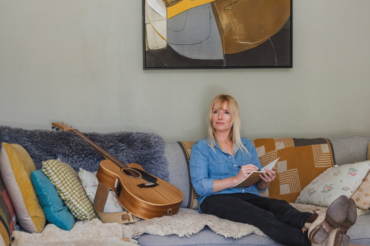
After five years living in New York, Hamish and Mez Keith have returned to Australia determined to give Bathurst its rightful place on the NSW tourism map.
Hamish Keith was just 12 years old when he stood in the cattle yards on his parents’ property, Wilga Station, looking out across the Bathurst Plains and declared he would one day build a house there. It took a few decades, but he and his wife, Mez, have finally achieved that ambition with an off-grid couple’s retreat called the Farmer’s Hut, which they built using mainly recycled materials in 2020, during their journey of restoration and hospitality.
The energetic and engaging couple didn’t stop there as the following year they completely gutted and restored the station’s shearing shed, now called the Shearers’ Hall, where they offer self-catering accommodation for up to 10 guests in an equally scenic spot on the farm. Then in 2022, they took on an even greater challenge, restoring the 19th-century Wool Store in the heart of Bathurst’s heritage precinct and turning it into six New York-style apartments, complete with a penthouse loft.
It’s been an extraordinary ride for the Keiths and their two daughters, Mina, aged 10, and Asha, seven, as until they moved to Bathurst in 2016, they’d been living and working in New York.
The journey began when Hamish left the family farm to go to boarding school in Sydney. He then went on to study hospitality and event management at the International College of Management on the campus of St Patrick’s, Manly, and to work as an events manager at the Hilton Hotel. It was there he met Mez, who had grown up in Sydney and took a job at the hotel while she was studying arts and commerce. They became a couple and Mez moved on to work in banking and complete a master’s degree in international relations.

“As part of that course, I had a six-month secondment at the United Nations in New York,” Mez says. “Hamish came with me and we fell in love with the city.”
Mez went on to gain a job working in New York with the NGO Charity: Water, which works towards bringing clean water and sanitation to the 2.2 billion people living in rural and remote communities around the world who don’t have safe drinking water and the 2 billion of them who don’t have access to toilets or latrines. Meanwhile, Hamish’s career as an event producer was booming, as he masterminded multi-million-dollar concerts, incentive dinners and corporate extravaganzas in exotic locations, wrangling guest lists of hundreds, celebrity performers and all the excesses of the post-recessionary 2010s in the US.
“It was a case of being in the right place at the right time,” Hamish says. “Australians are well-received in the States because we’re easy-going, confident, talk to everybody and, in a less-unionised society, we’re used to handling multi-faceted roles.”
Life was grand and both the girls were born in the Big Apple, but gradually Hamish and Mez came to the realisation that it was time to come home to Australia to be closer to family. “New York was fun and exciting, but it’s also intense, noisy and exhausting,” Mez says. “It was time to stop living in a tiny apartment in a concrete city.”

Hamish started scouting for a job in NSW and the move was sealed when he was hired as the CEO of one of the Bathurst region’s main tourist attractions, Mayfield Gardens, which is the largest private garden in the southern hemisphere, at 160 acres (65 hectares). “It was a simple transition for me as I’m from the country and I was coming home,” he says. “I was more concerned for Mez, who had never lived anywhere but cities.”
“I found it surprisingly easy,” Mez adds. “It was like I was suddenly breathing fresh air for the first time in a long while. We were lucky that we were immediately adopted into a community of Hamish’s old school friends, so we had an instant network. The girls have also thrived here. It’s just so easy to get them to school and after-school activities. There’s a very healthy arts community here and the Bathurst Regional Art Gallery is world-class. We have a large stadium for big acts and if you go to a show, you can usually park two minutes away from the venue.”
The Keiths have become great advocates for Bathurst, which they say for too long has been overshadowed by the nearby wine districts of Orange and Mudgee. “Bathurst has been something of a one-trick pony, in that it’s known as a motor-racing city,” Hamish says. “In fact, there’s only racing for six weeks of the year and the star event, the Bathurst 1000, actually only runs for a long weekend. While that is a great thing for racing enthusiasts, the good thing for those who are not into motor sport is there is much to discover at other times of the year.”
Bathurst has a rich supply of heritage buildings from its gold-mining past, a growing food, wine, distilling and brewing culture and there’s much to explore in the historic city and surrounding villages. Since celebrated chef Matt Moran invested in the Rockley Pub, many other investors and small business owners including The Grange Distillery’s Nick Jones and Linda Gregoriou, a sustainable property developer and owner of a soon-to-be restaurant, shopping and boutique hotel precinct in Tremains Mill, have jumped on the Bathurst bandwagon. They are working together on a program called Project Elevate to promote high-end tourism. Meanwhile, Matt has purchased another establishment in Bathurst, which he is turning into a high-end bakery to open in mid-2024.
Hamish and Mez have poured buckets of their own sweat and tears, not to mention blood blisters if not actual blood, into the city’s future with their three hospitality projects. Hamish’s mother, Denise, has also been a staunch ally, tirelessly sanding back and oiling salvaged timber for use in the buildings. While Hamish was very hands-on with the building project, Mez was the design guru, and continued to work as a project manager at Charles Sturt University to keep an income coming in. Since August last year, however, she’s given up her day job as they are now both full-time hoteliers.

“There was a lot of upcycling in the restorations,” Hamish says. “We stole every bit of timber we could from the sheep yards and scrap metal from the paddocks for the construction and we engaged a local joiner to make furniture and cabinetry from all the bits of wood. The challenge was to find the right mix of rustic with luxury and that’s where Mez has really nailed it. She has a great design instinct and could see potential where others might only have seen junk.”
The former wool-rolling table is now a dining room table in the Shearers’ Hall, the middle of a chute has been born again as a cabinet top, while the chutes themselves have been retained and covered with glass to reveal the shed’s previous life. Mez was also dogged when it came to sourcing the deep-red Bathurst bricks needed for the Wool Store restoration. Her diligence in searching out the right materials and furniture is evident in each venue and the results are in the bookings and accolades the properties are already garnering.
“We’re also excited to have uncovered some rich Aboriginal history on the station and we’re working with the local elders to include an Indigenous component to the station stays,” Hamish says. “It turns out there’s an important songline running through our property and there’s a large engraving of a long-necked turtle on rocks down near the creek. We’re looking forward to being able to share that rich history with our guests.”
It doesn’t take a rocket scientist to realise that in building their new life, the Keiths have also created
a great venue for future events.
“Ah, yes,” Hamish says. “I thought I had retired from events. They are a real time suck. But I might just stick my toe back in to create a bit of buzz about Bathurst. We already have a winter festival in July and a heritage festival in April, but I can see potential for long lunches, music festivals and Indigenous events. Whatever it takes really to get Bathurst buzzing again.”


